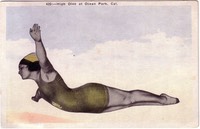Terrell C. Drinkwater History of the Los Angeles Country Club 1898-1973, Unknown publisher, 1973, 127 pp., 1898, 1897, 1927, 1946,
It was while Tufts, along with Walter Cosby, was trying out the just created Windmill links that the second man who was to have such a tremendous and lengthy impact on the Club entered into the picture.
He was a small, dark, stern-looking young banker, Joseph F. Sartori, and was to become the Club’s organizational and financial leader for 49 years. He was on the Club’s board from its founding until his death in 1946. Sartori served as president of The Los Angeles Country Club from 1912 to 1946, an unprecedented 34 years. He was, with Tufts, co-founder of the SCGA, its president from 1903 to 1905, and a longtime member of SCGA’s board.
While Tufts served golf, both in the Club and throughout Southern California, Sartori served the Club. For almost 50 years the man who was almost always known respectfully as “Mr. Sartori,” ruled the Club as, in the best sense of the term, a benevolent dictator.
As Tufts told the story, Cosby and he were playing one of the Windmill holes bordering Pico, then little more than a dusty road, when Sartori and a friend, Joseph E. Cook, rode by on their bicycles. The two cyclists were invited to try their hand at the game.
Sartori hit his first golf ball and, according to Tufts, the shot “turned out to be a lulu” and Sartori was hooked.
The smart residential area of Los Angeles in the 1880s and 1890s was the West Adams district and Tufts got a half dozen of the younger male residents interested in the new fangled game. They organized a voluntary organization, the Los Angeles Golf Club. Mark S. Severance was elected president and Conde Jones secretary. Tufts became the one-man handicapper and Sartori was chairman of the Green committee, a euphimism if there ever was on since there was hardly a green weed, let alone a blade of grass, on the area selected for Los Angeles’ first golf links
. . .
